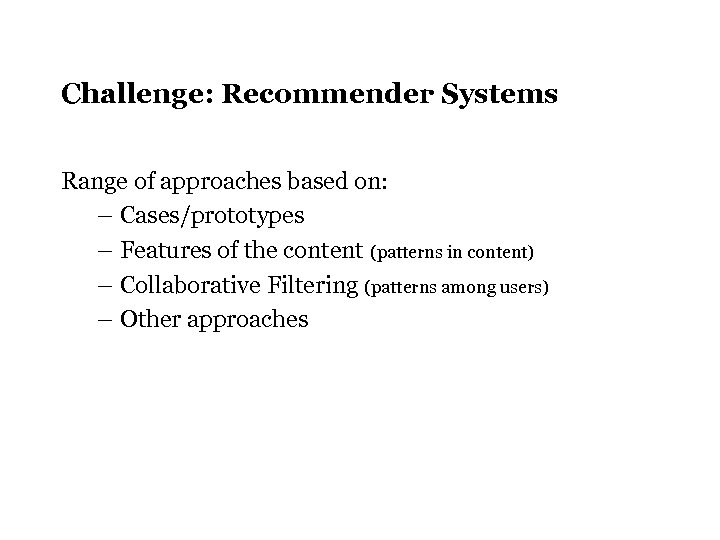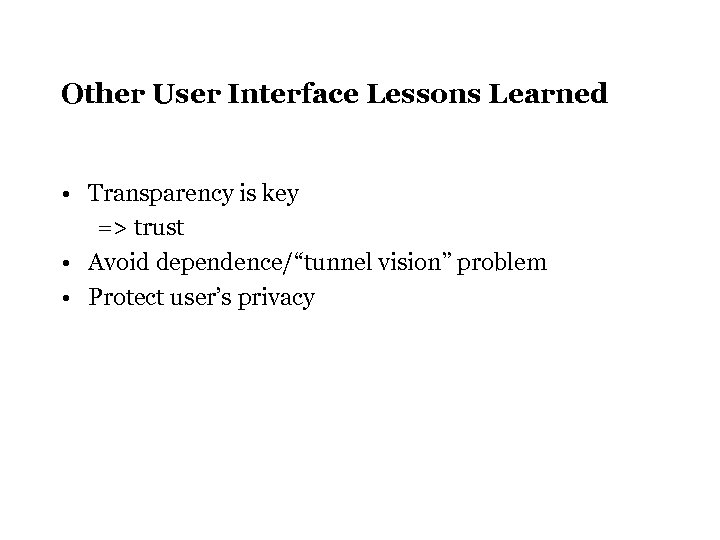5177bf3983b793eb54596f9647c46643.ppt
- Количество слайдов: 41

Ambient Intelligence Work at MIT Media Lab Pattie Maes MIT Media Laboratory pattie@media. mit. edu

Focus: Integrating the information world into the physical world Making available to a user information that is highly relevant to what s/he is currently doing

Why offer Information while people are “on the move”? • To make information more easily & readily available • To promote: – Insight – Inspiration – Interpersonal connections …without disrupting the user

Information While on the Move State of the art in mobile computing: • Too many clicks • Not enough screen space

Some of our work in this area • Software Agents Group (till 2001): – Remembrance agent – Periscope – Impulse – Hanging Messages • Ambient Intelligence Group (ongoing, since 2003): – What would they think? – Ether Threads – Ambient Semantics – Photowhere – Reach. Media – …

Remembrance agent (on Wearable) – Bradley Rhodes (2001) Contextspecific reminders of previous notes taken (based on location, day, time of day, other people present, conversation topics, …)

Periscope: A virtual Browser for the Real World – Jim Youll (2001) Camera with compass and range finder shows webpages about the location the user is focused on. (currently being implemented on mobile phone with GPS & possibly compass by Dan Relihan)

Impulse: Information Exchange with Entities in the Physical Vicinity - Joan Morris & Jim Youll (2000) The Coop Bookstore out of stock Harvard Univ. Bookstore lowest price $55 Brad’s Agent Wordsworth Bookstore lowest price $45 beep!

Hanging Messages – Emily Chang (2001) Using PDA + GPS, users can leave or receive location-based messages

Reach. Media: On-the-move Interaction with Augmented Objects – Assaf Feldman, Sajid Sadi 2005 • Wireless RFID reader wristband reads tags in objects held by user • Touching an object results in a menu of services and information: • • • Order a copy Read reviews Leave a message Retrieve messages Do a keyword search …

Reach. Media: On-the-move interaction with Augmented Objects – Assaf Feldman, Sajid Sadi 2005 • Wireless and mobile • Natural and seamless, hands-free and eyes-free interaction option: – Gesture input (accelerometers on wristband) – Audio output • Keypad & screen-based interaction option

Reach. Media: Video

Glasses subtle interface - Enrico Costanza (2005) Wearable peripheral display embedded in a pair of eyeglasses delivers notification cues in a private, subtle and non-obtrusive way

Ambient Semantics: Personalizing information presented on the Reach. Media Platform - Hugo Liu 2004 E. g. When user picks up a book with Reach. Media wristband, user’s cell pone conveys: – – – A prediction of how much user will like the book Which passages are relevant to user’s interests How it relates to other books recently read Reviews by respected friends/editors Which friends loved/hated it …

•


“Intelligence” methods used in Ambient Semantics project - Hugo Liu • Mining the web: – people’s homepages – social networks sites (Friendster, Linked. In, Orkut) – Amazon & Google • Using Natural Language Processing techniques and Common Sense knowledge • To find relevant connections (between 2 people, between person & object)

Interest. Map – Hugo Liu 2004 •

Photowhere: Automated annotation of photographs - Dan Relihan & Bradford Lassey 2004 • Cell phone communicates with GPS device via bluetooth to record location of picture taken • Phone interfaces to metacarta. com server to find URLs about that location • Extracts and offers keywords for the picture taken => Konica-Minolta & Nokia research licenses

Ether Threads: location-based messaging using a cell phone - Bradford Lassey 2004 Blue-tooth and GPS data trigger location-based messages relevant to the user and the threads s/he is interested in Þ France Telecom hired researchers

“What would they think? ” Virtual Mentors - Hugo Liu 2004 Uses NLP and “point-of-view processing” to show what some mentors have to say about the topic the user is focused on

Invisible Media: Sensing & responding to visual focus of attention - David Merrill 2005 -User wears earbud with IR emitter/receiver - Augmented objects sense the user’s focus of attention - Relevant information is presented in audio format -Speech input Þ Schlumberger trials & further development

Object Awareness: Drawing the person’s attention to objects of interest in the immediate environment - David Gatenby 2005 – Bluetooth-enabled cell phone communicates user’s interests to augmented objects in user’s vicinity – Relevant objects can draw the user’s attention by blinking their LED’s Functions: -Finding an object -Keyword search -Recommendations -Similarities -… Þ France Telecom research license

d-touch: Printable visual tags – Enrico Costanza Recognition of tags based on topology: - freedom for the shape of the tags - personalization - can accommodate aesthetic requirements - recognizable when bent

Challenges in Ubiquitous Information “Just-in-time” information is useful if it is: – likely to be relevant to the user • Challenges in: – user profiling – detecting context of user – recommendation algorithms – offered unobtrusively • Challenges in: – Subtle interfaces – requires minimal user effort to access • Challenges in: – Natural, “on-the-move” interfaces – safeguards the user’s privacy

Other Projects: Augmenting Everyday Objects with Specific Functionalities • • • Responsive portraits Responsive mirrors Augmented pillows Augmented fabrics for clothing & furniture Augmented doors, windows, walls, clocks, …

Moving Portraits: Portraits that react to a viewer’s presence & actions – Orit Zuckerman • Adding motion and interaction to traditional portraiture • Extending the relationship between the viewer, subject and artist

CASY: Responsive Portraits Support Staying in Touch - Orit Zuckerman 2005 • Context-based delivery of audio/video messages on PDA • Ex: – Grandparent records ‘good morning’ and ‘good night’ video snippets – Grandchild is shown the snippet in-context of going to sleep or waking up => BT collaboration

Aesthetiscope - Hugo Liu (2004)

Reflective Mirror - David Bouchard, Enrico Costanza 2005 Bathroom mirror allows person to reflect on their recent behavior. Uses half-way mirror & hidden LCD screen and camera. Þ Italian fashion industry collaboration

Identity Mirror – Hugo Liu 2005 Abstracted “mirror” reflects person’s “identity neighborhood” as gleaned from user’s homepage and public profiles pages

Pillow Talk - Amir Bakhtiar, Sajid Sadi & David Merrill 2005 A pair of networked touch-sensitive pillows with crude LED displays support synchronous, low-tech messaging

Summary Radically rethink user-information interaction by: – Offering “ubiquitous” information – Highly relevant to a unique user and their current focus of attention – In non-disruptive, easily accessible, privacy protecting way May replace traditional keyboard/screen based interface…

Just-in-time Information: Technical Challenges Just-in-time information “works” if it is: • likely to be relevant to the user – Challenges in: » user profiling » detecting context of user » recommendation algorithms (personalization, contextualization) • offered unobtrusively – Challenges in: » Subtle interfaces • requires minimal user effort to access – Challenges in: » Natural, “on-the-move” interfaces

Challenge: User Modeling/Profiling Approaches: – Entered explicitly by user • Form filling, choosing options in menu – Gathered implicitly by system • Data mining of observed user behavior • Data mining of personal texts – Eg homepages, profiles on social networking sites, files – Combination of approaches

Challenge: Detecting User Context • Detect who, what, where, when – Offer info relevant to current focus of user • Approaches: – On desktop: • Sense user’s actions in different applications – Offline: • Sensors in the environment & on user • May involve use of background knowledge & inferencing – E. g. shaking someone’s hand first time • Background info, creating connections, breaking the ice – versus shaking someone’s hand nth time • Reminders of previous conversations online/offline

Challenge: Recommender Systems Range of approaches based on: – Cases/prototypes – Features of the content (patterns in content) – Collaborative Filtering (patterns among users) – Other approaches

Challenge: Subtle, Natural Interfaces – Goals: • • Avoid change of focus/interruption Recommendations are proactive but easily ignorable Avoid additional gear/devices/windows Support “on-the-move” access to details – Approaches: 1. Either offer suggestions using secondary I/O modalities of user Eg peripheral vision, audio, gestures, etc 2. Or provide seamless integration of recommendations in existing interface in minimal way – Offer “ramping” interface • Present minimal “hints” • User controls access to more information/detail

Other User Interface Lessons Learned • Transparency is key => trust • Avoid dependence/“tunnel vision” problem • Protect user’s privacy

Impact • Always-present, pro-active, highly responsive interfaces make people more efficient, better informed. Examples: – Better memory (environment/objects around us “remember” and recall information) – More effective learning (just-in-time information is presented when user is most motivated to learn)

For More Information MIT Media Laboratory pattie@media. mit. edu www. media. mit. edu
5177bf3983b793eb54596f9647c46643.ppt